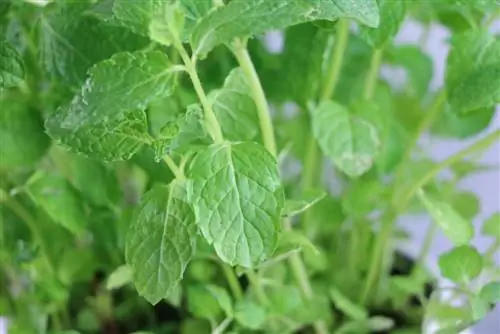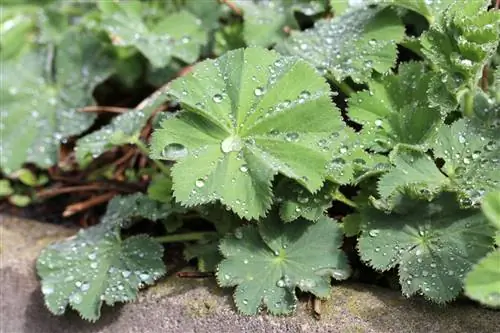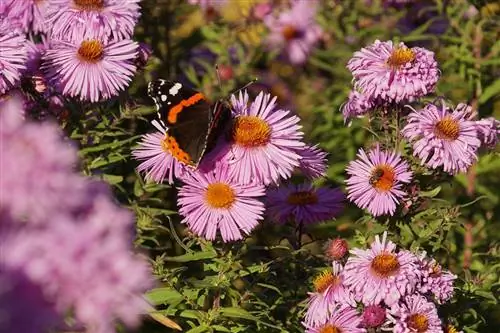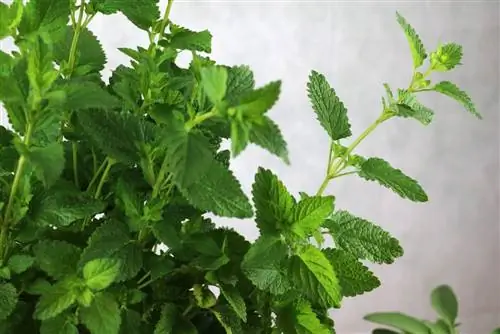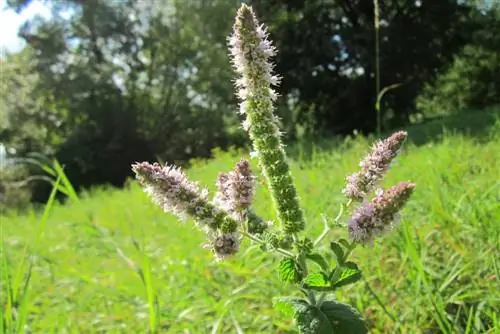- Author admin [email protected].
- Public 2023-12-17 03:39.
- Last modified 2025-01-24 12:45.
The particularly aromatic and tasty nana mint is extremely popular, but this is not only due to its taste. Compact in its growth habit and easy to care for, it can be easily grown even by beginners. A green thumb is also not necessary for lush appearance and high yields with Moroccan mint. Nevertheless, a few factors should be taken into account so that the spicy plant can develop its full beauty and characteristic strong taste.
Location
Moroccan Mint's name already gives an idea of what the location should look like. It has to be sunny and warm so that the aromatic plant feels comfortable. However, the nana mint does not necessarily need full sun; a semi-shady place is also sufficient. It should be noted that a very sunny location is synonymous with fast, vigorous growth and high water consumption. In the shade, however, the leaf mass only increases slowly.
Tip:
If it is a bed, there should be no mint plants at the location. These are also unfavorable as plant neighbors in the immediate vicinity.
Substrate
When it comes to the substrate, Moroccan mint is easy to care for. Basically, it thrives in any nutrient-rich garden soil. Ideally, this meets the following conditions:
- Loose, not prone to compaction
- Moist, with good water retention power
- Humos or loamy
- Neutral or slightly acidic pH value
Solid, compacted soil can also be suitable as long as it is loosened with sand. Under no circumstances should there be waterlogging, for example due to high groundwater, direct proximity to water or a lack of drainage.
Plants in the bed

If Moroccan mint is to be grown in the bed, it can only begin in late spring or early summer. Although the plant is relatively winter-hardy once it has grown, late frost shortly after planting the nana mint can cause serious damage to the plant and lead to it dying. If you want to be absolutely sure that your cultivation will be successful, you can go directly to pre-grown plants from the shops. With the exception of the cultivated form Mentha x piperita, the nana mint can also be pre-germinated from seeds. The procedure should be as follows:
- In March or April, fill small pots or a box with potting soil.
- Make sure there is sufficient water drainage in the containers.
- Wet the substrate well by dipping it in a bucket of water or by watering.
- Place the Moroccan mint seeds on the soil and do not cover them with the substrate or only cover them very lightly.
- Move the planters to a bright, warm place. 18 to 22°C is optimal.
- Always keep the soil slightly moist. If the air in the room is very dry, we also recommend a cover made of transparent film or glass or the use of an indoor greenhouse.
- Germination should begin after two to three weeks. Once the young plants have reached a height of around ten centimeters, they can be planted outdoors.
Whether you grow it yourself or buy it, when growing nana mint, the plants are first watered again or the planters are dipped. They are then planted in the bed at least 40 centimeters apart. The soil should be free of weeds and foreign roots.
Tip:
Moroccan mint tends to spread widely. If you want to prevent this, you should put in a large pot without a bottom or another root barrier.
Growing in a container
It is easy to grow Moroccan mint even without a bed. Since the nana mint spreads primarily flat rather than deeply, the optimal planter should have a large circumference but may be low in height. In addition, water drainage should be ensured through sufficient holes or a drainage layer made of broken clay or coarse gravel at the bottom. A mixture of pot soil and sand or herb soil is also suitable for cultivation in the pot.
Watering and fertilizing
The Moroccan mint must always be kept moist and quickly suffers from dryness. However, it also cannot tolerate waterlogging. Watering during the warm months should therefore be carried out regularly and as needed. The nana mint must not dry out even in winter. However, restraint is required here. Watering should be small and only occur on frost-free days. In any case, you should use soft water. Rain or untreated pond water is ideal. Alternatively, stale tap water is also suitable.
Planted in fresh and nutrient-rich soil, the mint does not require any additional fertilization during its first year of growth. From the second year onwards, it can benefit from additional nutrients both in the bed and in the pot. Organic products are used, such as nettle manure, compost or horn shavings. Alternatively, special herbal fertilizer is also suitable. The first dose is given when new shoots begin, around April or May. A second fertilization can be applied two to three months later - but not later than September.
Blend and harvest
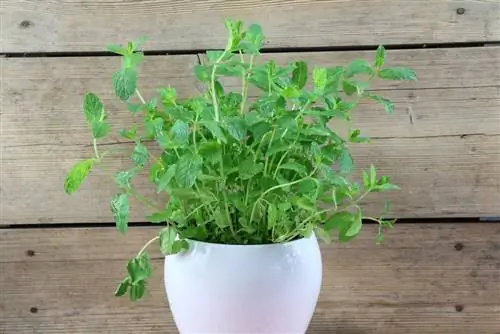
Individual stems of nana mint can be harvested from spring to autumn and as needed. If fresh leaves are not needed at the moment, you should still use scissors in May or early June. The cuttings are radical and up to one or two hand's breadths above the ground. As a result, the Moroccan mint then grows more densely branched. Later in the summer, the plant should be thinned out every now and then. Otherwise, growth may become too dense, causing some leaves to obscure others. Unsightly discoloration and a loss of aroma are the consequences of this partial lack of sun.
Propagation
Moroccan mint is propagated either via seeds, offshoots or runners. The only exception is the aforementioned Mentha x piperita cultivar, which can only be propagated via offshoots and runners. It is particularly easy to separate and plant runners or runners separately.
- If smaller plants emerge from the soil around the nana mint, they are plucked out and dug in a generous radius.
- The young plants obtained in this way are briefly immersed in water together with the soil.
- When planted separately, the young mints grow quickly and vigorously in the right location.
If you don't want to wait for the runners to appear, you can carefully place a strong outer shoot of the Moroccan mint on the ground and weigh it down with a stone near the mother plant. After about three weeks, the stone is lifted for inspection. If roots have formed underneath it, the shoot can be separated and planted elsewhere. Otherwise the stone will be put back on and waited a little longer.
Wintering
When overwintering in the bed, the Moroccan mint is protected from frost directly with a layer of leaves, mulch or straw. When grown in a pot, Nana mint should ideally be overwintered indoors. To do this, it is placed in the dark at around 10°C. If an appropriate area in the house is not available, the plant can also survive the cold season outdoors. However, it is necessary to install appropriate protection. Wrapped in garden fleece, blankets or foil, the bucket is placed on an insulating base - for example Styrofoam or several layers of cardboard. Whether in the bed or cellar, the soil must not dry out in any case. Outside, water is only watered on frost-free days and then only in very small quantities. If the winter quarters are in the house, watering is allowed every few days - but even here only a little.
Conclusion
Moroccan mint is ideal for tea and cocktails, as an edible decoration or ingredient in salads and desserts. Thanks to its strong aroma and growth and low maintenance requirements, it is a wonderful addition to the garden and kitchen - and he althy too.

